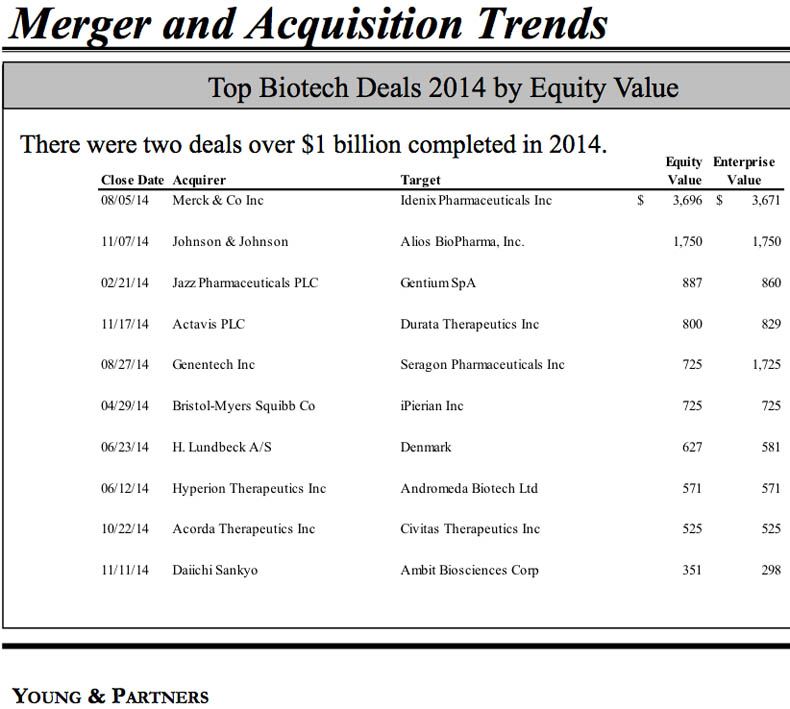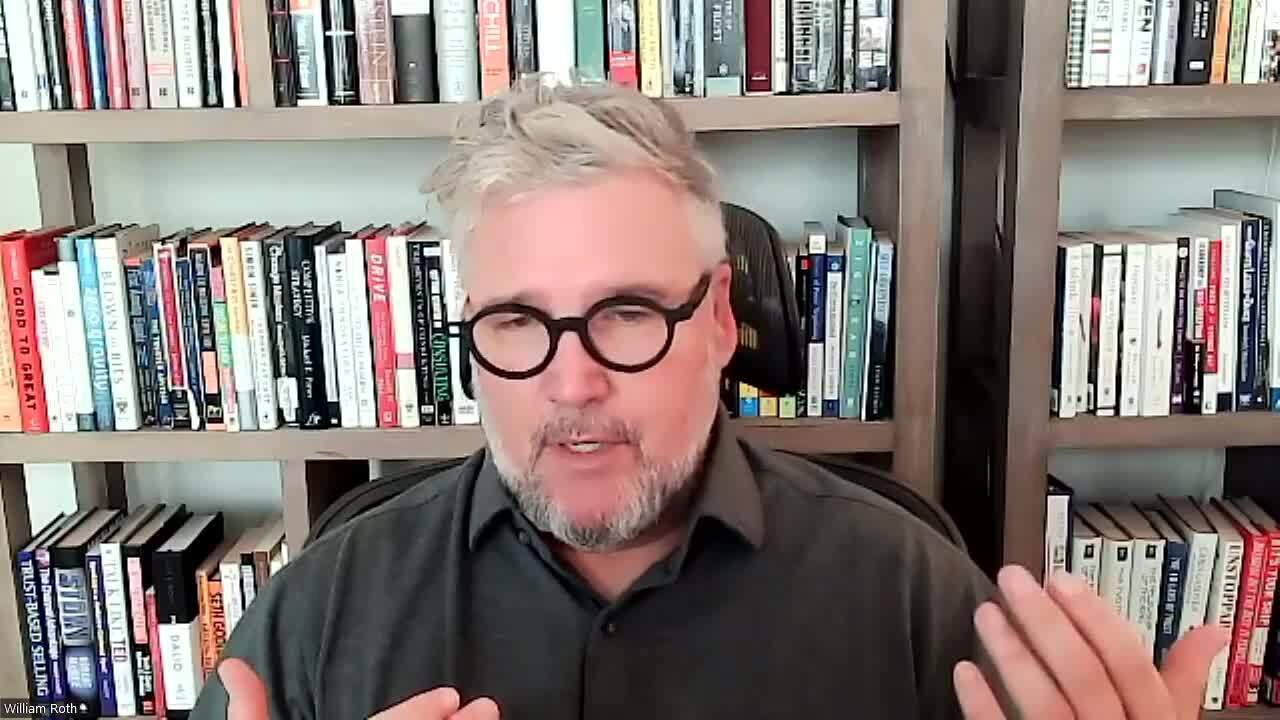A Wild Ride: Biotech Financial and M&A Trends 2014
Peter Young examines the positive drivers affecting the biotech industry and what happened on the M&A, IPO and financial fronts in biotech in 2014 - and what to expect in 2015.
Peter Young, President and Managing Director of Young & Partners, examines the positive drivers that are affecting the biotech industry and what happened on the M&A, IPO and financial fronts in Biotech in 2014 and what to expect in 2015.

2014 was a very exciting year for the biotech industry. Although the industry faces challenges related to the cost of drug development, changing patent laws, and other ongoing issues, these are very positive times for the biotech industry from a stock market, IPO, venture funding, M&A and partnering perspective.
Highlighted in this article are these and other details from the “Biotech Strategic, M&A, and Financial Trends Report,” recently completed by Young & Partners (Y&P), that covers all of 2014 and the outlook for the future.
Biotech Business Trends
On the biotech side, the biotech industry has grown significantly and will continue to grow with a number of positive headwinds in their favor.
Biotech companies are clearly demonstrating their ability to develop drug candidates in important mainstream and interesting orphan/niche markets. Biotechnology company innovation has been very successful and continues to outstrip the pace of the pharmaceutical companies. Biologics can hold on to their markets longer because production is too complicated and expensive for most generic manufacturers and the regulatory pathway for biogenerics is only beginning to develop, especially in the US.
Pharmaceutical company need for new products and pipeline have bid up prices for acquisitions and licensing deals in certain therapeutic categories and for companies and products that address desirable targets.
The stock market has rewarded biotech companies that report positive clinical data and a number of these companies have been able to raise significant capital in follow-on offerings.
The high volume of IPOs in 2013 and 2014 has provided much needed capital and investor liquidity for the biotech companies. Venture capital funding has also been available.
The growth of orphan drugs and drugs addressing unmet medical needs in specialty areas has been positive for biotech.
The biotech companies have been receiving biologics treatment that has been favorable. In general, innovator biologics have 12 years of data exclusivity on top of the existing patent lives and biosimilar applications for approval cannot be filed until four years after the first license of the reference innovator biologic. This was a heavy blow to generic drug producers and a major victory to branded biologic drug producers. The bill does establish an abbreviated licensing procedure for biosimilars.
Biotech companies have been heavily in favor in the stock market and this appears to be continuing, in spite of some periodic dips. Biotech companies are now clearly in favor and have been for some time and the share prices of biotech companies have benefited. Investors are excited about the new products and technologies and are strong believers that the biotech business model is working.
Against a general market that increased by 11% in 2014, the Y&P Large Cap Biotech, Y&P Mid Cap Biotech, and Y&P Small Cap Biotech indices did exceptionally well, increasing by 29.6%, 32.8% and 32.4%, respectively. Valuations, as a result, have soared.
Biotech M&A
Biotech M&A activity has almost always been modest historically, with spurts of activity from time to time. Note that we define biotech as companies with products under development, but no marketed products. Dollar volume has increased recently, but the number of deals has been flat. In 2014 there were 27 biotech M&A deals completed worth $12.7 billion. This compares to 27 deals worth $7.1 billion in 2013.
Most of the deals were under $1 billion, with the exception of Johnson & Johnson’s acquisition of Alios Biopharma ($1.7 billion) and Merck’s acquisition of Idenix ($3.7 billion).
As of yearend, the deals announced but not closed was only $641 million (1 deal).
Why is M&A volume relatively low? Part of the reason is that there are very active and viable alternatives such as partnering and licensing that are being used to provide quasi liquidity and to manage risk. A combination of high stock market valuations and the bidding up of prices for late-stage biotech companies has only partially dampened the pharma company pursuit of biotech companies, but pharma companies have used partnering and licensing where they can.
Biotech Debt and Equity Financing
Only $927 million of non-bank debt was issued in 2014 compared to $592 million for all of 2013, a meaningful increase, but off of a very small base.
On the other hand, equity issuance in 2014 was 167 offerings worth $14.1 billion compared to 114 offerings worth $8.2 billion in 2013, an all-time record for the biotech industry.
IPOs are a subset of the total equity issuance market. The IPO market has been exceptionally strong, fueled by a surging stock market and very positive biotech stock price performance. 2014 issuance included 72 IPOs totaling $5.7 billion, the highest total in biotech history. This was a huge increase over the 36 IPOs totaling $2.6 billion completed in 2013.
Biotech: What will the future bring?
The development capabilities of biotech companies have been and will continue to be positive overall. Although there will be successes and failures by individual companies, biotech companies are demonstrating and will continue to demonstrate their ability to successfully develop new drugs.
Biotech M&A will continue to be active, with the primary theme being pharma and big biotech acquisitions of biotech companies for pipeline enhancement. However, M&A dollar volume will continue to be modest, mainly because pharma and big biotech companies are heavily using non-M&A methods to achieve their pipeline goals, such as licensing and partnering.
M&A valuations will continue to be high, with the most promising biotech companies at all stages attracting the greatest interest and relatively high prices.
IPO and venture funding will continue to be strong as investor sentiment continues to be very positive.
Barring a major disruption in the global equity markets, we expect the positive environment for equity funding to continue.

Peter Young is President and Managing Director of Young & Partners, the Life Science Investment Banking firm.
He can be reached at pyoung@youngandpartners.com.
Cell and Gene Therapy Check-in 2024
January 18th 2024Fran Gregory, VP of Emerging Therapies, Cardinal Health discusses her career, how both CAR-T therapies and personalization have been gaining momentum and what kind of progress we expect to see from them, some of the biggest hurdles facing their section of the industry, the importance of patient advocacy and so much more.
Applying Porter’s Five Forces to Portfolio Management in Pharmaceutical R&D: A Strategic Roadmap
March 17th 2025The increasing costs and complexity of R&D in the pharmaceutical industry have necessitated the adoption of strategic portfolio management to optimize resource allocation and enhance competitive advantage.

.png&w=3840&q=75)

.png&w=3840&q=75)



.png&w=3840&q=75)



.png&w=3840&q=75)




